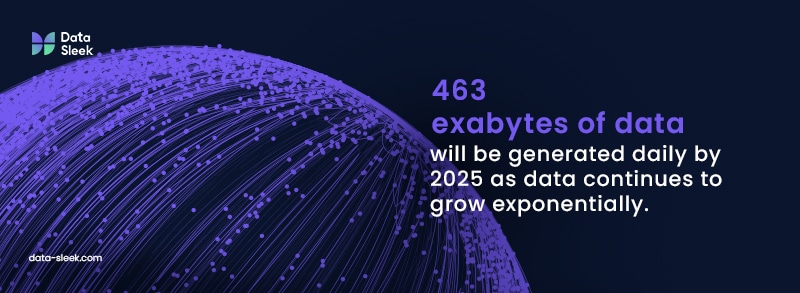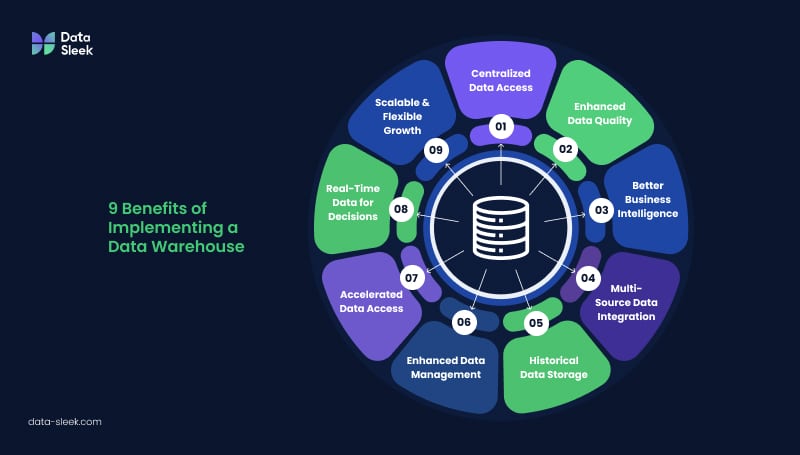
Maybe you’re at a point in your business where you ask yourself, “Do I need a data warehouse?” It’s a valid question, especially as your company grows and the valuable data you handle seems to multiply every day.

In fact, 53% of organizations plan to increase their investment in data warehousing services and technologies in the next two years. That’s because managing growing volumes of data can quickly become overwhelming, and many businesses find that their existing systems just can’t keep up.

As data continues to grow exponentially—up to 463 exabytes of data will be generated daily by 2025—small businesses face challenges like slow reporting, fragmented data across multiple tools, and missed insights that could drive business growth. If you find your team spending more time cleaning or hunting for data rather than analyzing it, it might be time to consider a data warehouse.
But how do you know when it’s the right time to invest? Let’s look at some key indicators that suggest you may need a data warehouse solution.
5 Top Signs Your Business Needs a Data Warehouse Solution
So, how do you know if it’s time for your business to make the leap to a data warehouse? While every company is different, a few common signs point to the need for data warehouse solutions. Let’s explore the key indicators that suggest your business is ready for a data warehouse.
1. Growing Data Volume
As your business grows, the amount of data you manage daily can quickly become overwhelming if you’re still using simple tools like Excel sheets or outdated systems. At first, everything might seem fine, but as data piles up, you’ll start noticing slowdowns. Reports take longer to generate, and it becomes harder to find specific information.
One of the main challenges with growing data volume is that it slows down decision-making. When you’re dealing with thousands of customer records, transactions, or sales data, it becomes tough to get clear insights fast. Your data analytics team may end up may end up spending more time organizing or cleaning data than actually analyzing it. This wastes valuable time and prevents quick, informed decisions.
As data grows, errors like duplicates or missing information also become more common, making it harder to trust your insights. If you’re frequently seeing these delays and data issues, it’s a sign your current system may not handle the increasing data load.
If performance issues are constant problems, it might be time to rethink how you’re managing your data. These challenges suggest your current tools can’t keep up with your expanding business needs.

2. Multiple Data Sources
If your business relies on data from multiple platforms—like sales software, CRM tools, and marketing platforms—it can be tough to get a clear, consistent picture of your performance. Each system has its own format, which makes it difficult to combine everything in a way that makes sense. This often leads to inconsistencies and manual processes that eat up valuable time.
When data comes from various sources, things can quickly get messy. Reports might not match up because the data sources aren’t aligned, and your data engineering team could spend could spend hours piecing together information just to get basic insights. This increases the risk of errors and slows down your ability to make informed decisions.
Manually merging data often results in missing fields, mismatched numbers, or inconsistent formats. Even if you manage to pull a report together, the data might change the next time you run it, leading to even more confusion. This back-and-forth slows down your operations and prevents your team from focusing on more important tasks.
If you’re struggling to manage data from different platforms and finding it harder to get accurate reports, it’s a sign that you need a data warehouse solution. Otherwise, you risk unclear insights and unnecessary complexity.
3. Need for Better Reporting and Analytics
A common sign your business needs a data warehouse is that it struggles with reporting and data analytics. As your company grows, the reports that used to be quick and accurate can become slow, incomplete, or error-prone. With data scattered across different systems, pulling together a comprehensive report can be frustrating and time-consuming.
Without a data warehousing solution, you may rely on manual processes, increasing the chances of errors. Inaccurate or incomplete data analysis can lead to poor business strategies or missed opportunities. Implementing a data warehouse architecture will improve the business intelligence (BI) process, allowing data analysts to focus on deriving insights rather than fixing errors.

4. Data Quality and Consistency Issues
As your business grows and you handle more data from different sources, maintaining high data quality and consistency becomes a challenge. You might notice discrepancies in customer information, mismatched records, or duplicated data across systems. When data is collected from multiple sources and stored in different formats, it’s easy for errors to creep in. This leads to unreliable data, which can skew reports and affect decision-making.
One reason for errors is the lack of automation. Automated data transformation can help streamline data processing and reduce the manual work needed to clean and organize data. Without automation, teams are often left manually entering, reformatting, and correcting data, which increases the chances of human error. Automating data handling improves accuracy and ensures that data is consistently formatted and integrated across different platforms, leading to more reliable outcomes.
Data quality issues are often a sign that your current system is struggling to keep up. If your team is constantly fixing errors, rechecking reports, or dealing with inconsistent data, it’s a red flag that your processes aren’t scalable. Inaccurate or inconsistent data can also hurt customer relationships, especially if it leads to mistakes in orders, billing, or communication.
5. Need for Historical Data
If your business relies heavily on tracking past trends, monitoring performance over time, or making decisions based on historical information, you’ve probably run into issues with keeping everything organized.
As your company grows, it generates more and more data—whether it’s sales figures, customer interactions, or performance metrics—and storing it all in scattered systems makes it harder to retrieve when needed.
Over time, retrieving data from different systems becomes a slow, frustrating process. You might find it difficult to pull old reports or access the data needed for forecasting and trend analysis. This can slow down strategic planning and lead to missed opportunities.
Additionally, industries that require regulatory compliance, like finance or healthcare, need to keep accurate historical records for audits or legal requirements. If you’re constantly digging through multiple systems to find older records, that’s a clear sign your current setup isn’t working and you need a data warehouse.

9 Benefits of Implementing a Data Warehouse
One of the biggest perks of data warehousing is how easily you can pull data from different systems, providing your company with real business value by enabling smarter decisions based on a single source. But that’s just the start—there are plenty more benefits to explore.
1. Centralized Data Access
A data warehouse acts as a central location that pulls data from multiple sources like operational systems, external sources, and transactional databases. This allows data analysts and business users to access the same data quickly for analysis, improving decision-making across the company.
2. Enhanced Data Quality
Data warehousing ensures data integration from various sources, meaning the data transformation process makes sure only accurate data is stored. This leads to enhanced data quality, ensuring that business decisions are based on valuable insights from clean and consistent data sets.
3. Better Business Intelligence (BI)
A data warehouse integrates seamlessly with BI tools like Power BI, Tableau, and others, allowing businesses to run real-time reports and perform data analysis effectively. Combining a modern data warehouse with a robust BI tool, companies can make quick, data-driven decisions, offering real-time insights and adding significant value to their operations.
4. Combining Data from Multiple Sources
Data warehouses allow you to blend data from different systems, such as the production database, operational data store, and data mart. This means you can pull together both structured data and unstructured data from different data types to get a full view of your business data.
5. Historical Data Storage
A data warehouse is a central repository that stores data for the long term, making it easier to track historical information. This helps understand trends, which is essential for businesses to improve their business intelligence efforts and predict future performance based on historical data.
6. Improved Data Management
An enterprise data warehouse allows businesses to store large volumes of data from various sources in a centralized and organized manner. Tools such as SQL Server help structure this data, making it easier to manage, query, and analyze. Efficient data management streamlines data exploration and facilitates better data modeling, leading to more accurate and actionable insights.
7. Faster Data Access for Analysis
With a single system to manage all data, business users can quickly access and analyze data without pulling it from multiple systems. Massively parallel processing in modern data warehouses allows for efficient handling of big data sets, speeding up the entire process of data-driven analytics.
8. Supports Business Decisions With Real-Time Data
Some modern data warehouses are equipped to handle real-time data from transactional data and operational systems, offering businesses real-time performance insights. This enables quick decision-making based on the most current data available.
9. Scalability and Flexibility for Business Growth
As your business grows, your data warehouse can scale to handle more business data and support new data sources like data lake and data mart. This flexibility makes it easier to support new technologies and accommodate growing data needs without starting a whole new data warehouse project.
Case Study: How Data Warehouses Empower Different Business Sectors
Data warehouses have become essential tools for businesses across various sectors, helping them manage and analyze large amounts of data more effectively. This case study will explore how data warehouses empower retail, healthcare, and financial services industries to overcome data challenges, streamline operations, and make smarter decisions.

In the Retail Industry
In the retail sector, data warehouses are critical in helping businesses manage large volumes of data coming from various channels, such as physical stores and e-commerce platforms. A data warehouse enables retailers to integrate data from operational databases, data marts, and source systems to create a single source of truth.
For instance, Sqquid, a retail management platform, faced challenges managing data from its omnichannel retailing services. By implementing a modern data warehouse, Sqquid overcome bottlenecks caused by its complex data structures. The new data warehouse solution allows Sqquid to combine data from multiple sales channels, operational data stores, and even Excel sheets, improving its performance significantly.
With a data lake house approach, Sqquid could handle structured and unstructured data, offering real-time analytics. The data warehouse project enabled the company to streamline operations by providing a centralized platform that improved query performance and allowed for faster inventory management. As a result, Sqquid efficiently integrated complex data from multiple sales channels, leading to a 50% reduction in inventory management costs.

In the Healthcare Sector
Healthcare organizations, like Health Karma, rely heavily on data warehouses to manage patient information from various source systems, such as telehealth platforms, pharmacy services, and specialty care. Health Karma’s challenge was handling fragmented patient data across its telehealth services.
To solve this, it implemented a data warehouse and data lake that could extract, load, and transform data into a usable format. This data warehouse project allowed Health Karma to create personalized health recommendations for its users by seamlessly integrating data from different sources and systems.
Health Karma’s modern data warehouse also enhanced the security of patient data, ensuring compliance with healthcare regulations. By creating a unified data dashboard through its data warehouse, the company improved customer segmentation and business intelligence, which led to a 25% increase in conversion rates. The ability to generate real-time insights from patient data and store health histories securely gave Health Karma the agility to grow while providing accurate recommendations to its users.
FAQ
When Should You Build a Data Warehouse?
Build a data warehouse when you need to consolidate and analyze large amounts of data from multiple sources to support business intelligence and decision-making.
When Should You Copy Data To Your Data Warehouse?
You should copy data to your data warehouse as soon as possible to capture historical data.
How Much Does Implementing A Data Warehouse Cost?
The cost to implement a data warehouse can vary widely depending on the specific requirements, size, and complexity of the project. Factors that impact the cost include the amount of data, number of data sources, hardware and software needs, staffing requirements, and the level of customization required. On average, the total cost can range from $30,000 to $2 million or more.
Build Your Scalable Data Warehouse With Data Sleek
If you’re seeing the signs—sluggish reports, scattered data, slow decision-making—it’s clear: you need a data warehouse. Don’t let your team struggle with outdated systems and messy data. Now is the time to take control!
At Data Sleek, we help businesses build scalable data warehouses that solve these exact issues. From strategy and design to full implementation and optimization, our team of experts is ready to guide you through every step of the process. No more struggling with complex data or piecing together unreliable insights.
Get your business back on track with a custom data warehouse solution that grows with you. Contact Data Sleek today, and let’s turn your data challenges into opportunities!



